Our year is starting off with a whole new house renovation, with three different bathroom designs! Bathrooms are one of my favorite spaces to design (second only to kids rooms) so naturally, I’ve spent countless hours gathering ideas and inspiration. Keep reading to discover my top ten bathroom trends designers are loving this year.

I’m not sharing this list to convince you to follow the trends—but rather to share my observations as a designer. It’s fun to discover new ideas, recognize patterns in the design world, and anticipate what’s ahead.
The overarching theme across these design trends is a shift towards timeless, classic design and a desire to use natural, raw materials that won’t look dated in a few years. While these trends are popular right now, they’re actually all timeless on their own. It’s not the materials you use, but how you use them that makes them trendy or timeless.
Jump to:
1. Moody Marble
Step aside zellige tile, veiny marble is the new go-to material for bathrooms. From shower walls to countertops, trim and sinks—every surface is fair game.

You can’t open Instagram or Pinterest without seeing in your feed, and in nearly every designer’s work. This natural stone exudes luxury and elegance, but it also comes at a cost—both in price and upkeep.

Although there’s been a recent surge in popularity, this timeless material has been around for thousands of years. If it was good enough to use in the Taj Mahal, Buckingham Palace and the Pantheon—rest assured, it’s a safe choice for your bathroom.

If you’re worried about it looking dated in a few years, go with a more subtle veining and neutral color, or limit its use to just one surface.

2. Checkerboard Tile
You may have noticed checkerboard tile floors everywhere in the last couple years, and it’s one of the undisputed design trends of 2024.

We can attribute it’s popularity to a variety of factors, including its timeless aesthetic, versatility, visual interest, and mix of traditional and modern appeal.

While checkerboard is a traditional pattern, there are many ways to make it unique and fun—like grouping multiple small tiles together, or experimenting with different materials and colors.

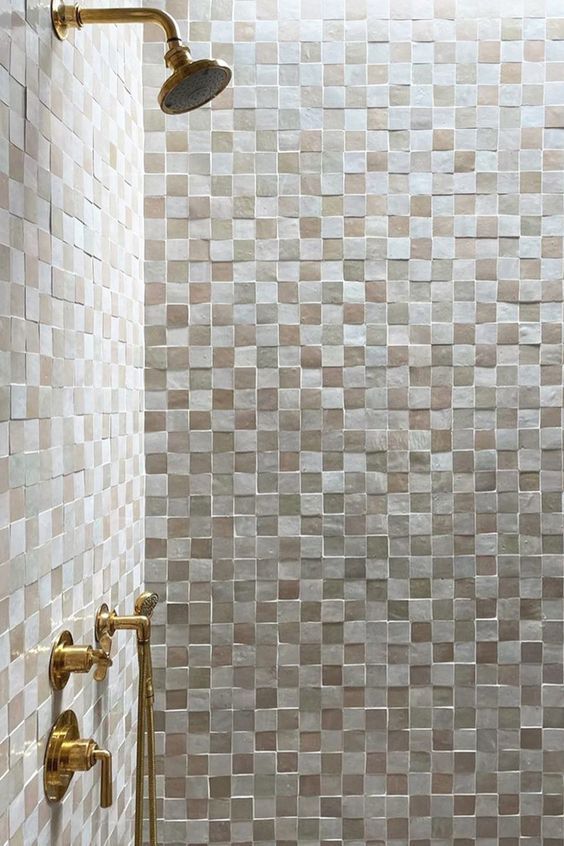
This versatility allows homeowners and designers to customize the look to match different preferences and bathroom styles. I plan on using checkered travertine in the backyard at the new house, and can’t wait to share more!

3. Stone Floors
Stone floors are another historic feature that many designers are leaning into this year. We’re seeing a lot of limestone, flagstone, travertine, slate and porcelain tile made to look like natural stone.


Apart from their timeless appeal, stone floors are durable, water resistant, and typically low maintenance. There are also many options when it comes to material, color, shape and size.

You can lay them in traditional patterns such as brick, cobblestone or diagonal, or get more creative with basketweave, checkerboard and other unique variations. I’ve got my eye on these for our next primary bathroom project!

4. Statement Sinks
From rustic stone troughs to antique marble vessels, designers are using sinks as focal points in bathrooms more than ever.

While often found in powder or guest bathrooms where counter space isn’t as critical, there are many ways to combine eye-catching materials or shapes with practical every-day use.
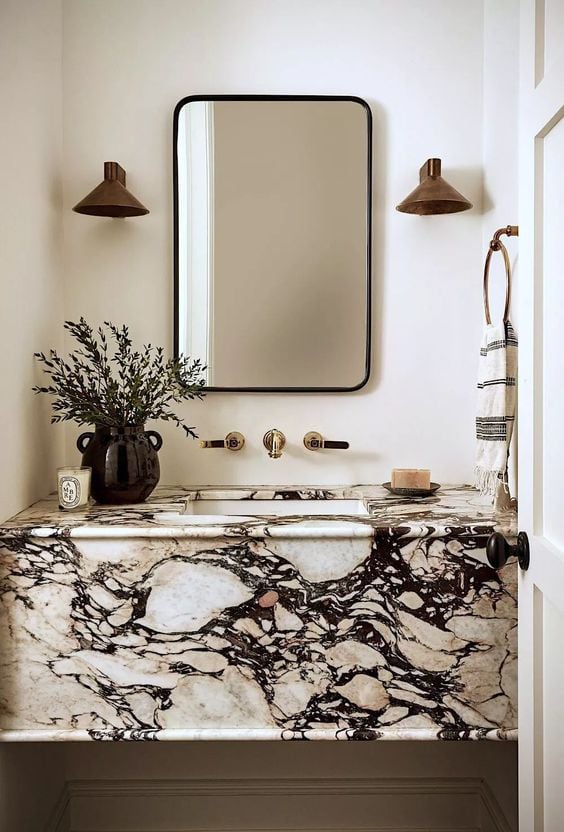
These vessels can be a work of art, and an opportunity to stand out with one-of-a-kind designs that tell a story.
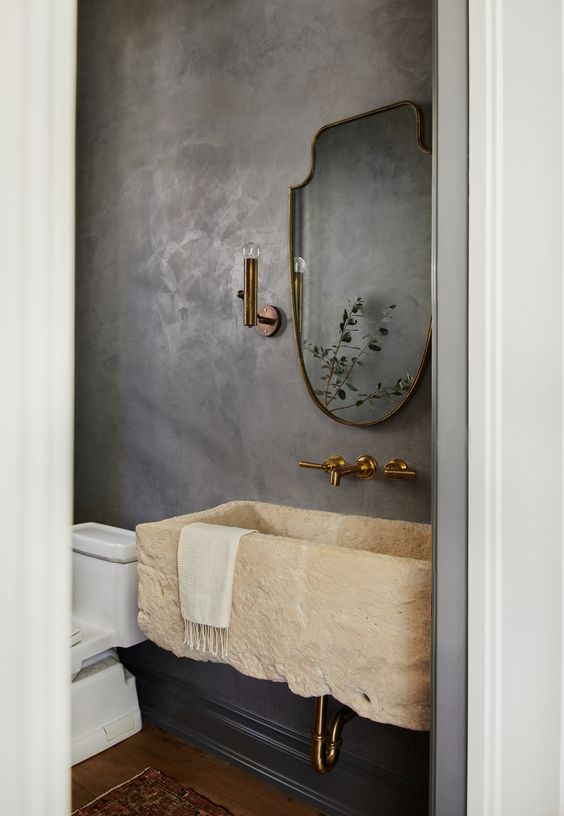
You’ll often find sinks integrated into the countertop or even backsplash, as one seamless focal point (as shown below).

5. Rich Reds
If the “moody, warm, traditional and unexpected” trends were encapsulated in a color, it would be called dark red.

With safe and predictable neutrals so prevalent in recent years, designers are seeking more personality, more drama, and taking more risks with color.

Red is certainly a polarizing shade in the design world, but there are ways to apply it tastefully. To avoid looking like a fast food restaurant, opt for a deep red with a neutral brown base, like Drew chose for this vanity below.

Want to try it but afraid to commit? Instead of permanent features like tile, consider introducing it as an accent—accessories, artwork, vanity or walls that can easily be repainted over later.

6. Wood Tones
In today’s design landscape, there’s a heightened desire for character and warmth in living spaces, and nothing accomplishes this better than real wood.

I think part of the resurgence is a direct response to the prevailing “trends” of the past decade (thanks, HGTV and house flippers). You know—the cold and stark white, gray and black rooms devoid of any depth or personality.

WIth a desire for moodier spaces, we’ve also seen darker wood tones become more popular—another reaction to the whitewashed wood that has reigned supreme in recent years.

One of my design rules is to incorporate wood into every room, and bathrooms are no exception. Can’t find a good place to add wood? There are a few convincing wood-look tile options, like this ribbed tile I used in the Hacienda Hideaway. It’s stunning in person and creates a spa-like feel without the upkeep of raw wood.

7. Plaster + Limewashed Walls
One of the oldest building materials on record, plaster walls have been the worldwide standard since 7500BC. Today’s modern take can be achieved with a variety of finishes designed to produce the same old world, ethereal look.

No, we’re not talking about the sponge painted tuscan walls from the 90’s. Current plaster wall alternatives have a more subtle and organic appearance, creating movement and understated elegance. They’re typically made with natural materials like venetian plaster, limewash, roman clay, tadelakt, and microcement.

Some of these techniques can be used on shower walls and floors, countertops and tubs. The appearance can range from rough and textured, to smooth and reflective. They can be tinted to any desired color, with either slight or dramatic variation.

As demand increases, more products are becoming available to homeowners and DIYers (check out my DIY limewash, venetian plaster and microcement tutorials!) These coatings are become a popular choice thanks to their affordability, and high-end aesthetic. If a minimalist, old world or luxury spa is the vibe you’re after, consider one of these wall treatments for your bathroom.

8. Framed shower enclosures
Shower enclosures have come a long way from the thick, yellow brass door frames from our childhood. Modern day designs feel sophisticated, unexpected and custom.

From simple fixed panel frames to intricate window grids reminiscent of a greenhouse, this trend can be incorporated into any shape or size shower. While normally this would require a custom shower glass installer, there are creative ways to DIY it (like Coco & Jack did below).
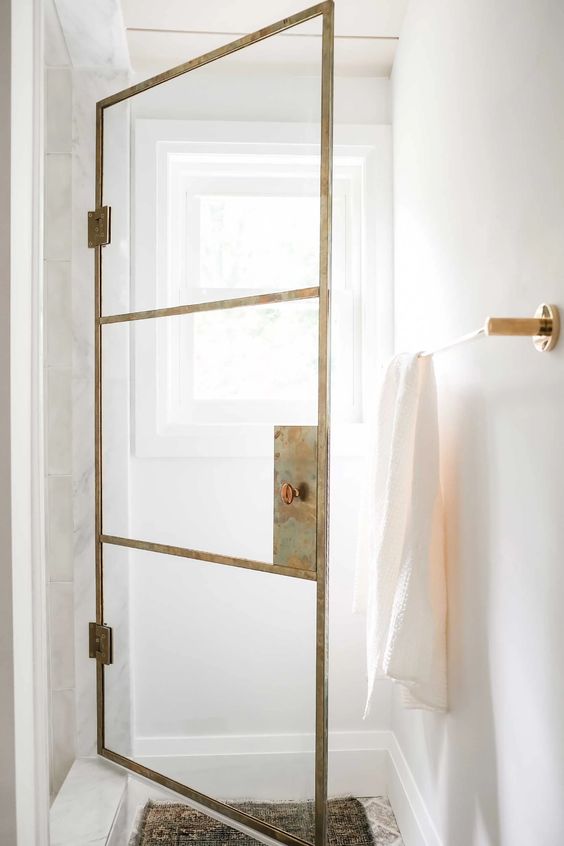
Aged brass appears to be the most popular metal choice at the moment, but white or even painted/powdercoated grids are an interesting option.

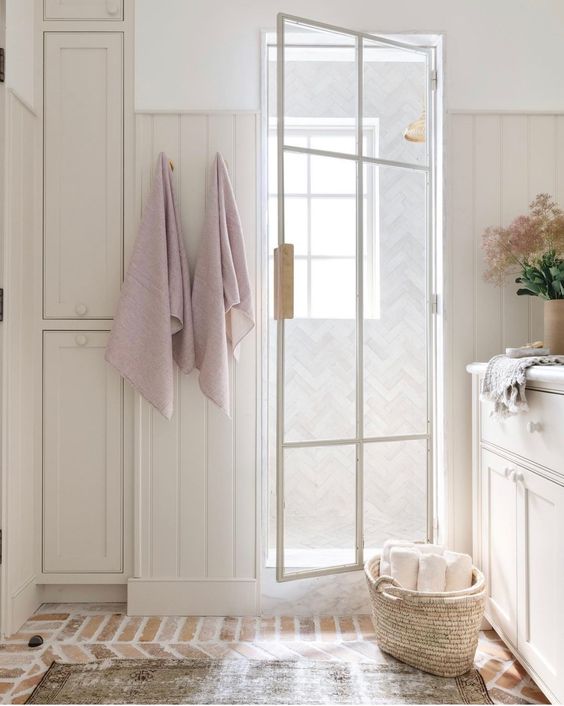
Personally, I’m excited to see an alternative to the predictable frameless shower doors that have prevailed for so long.
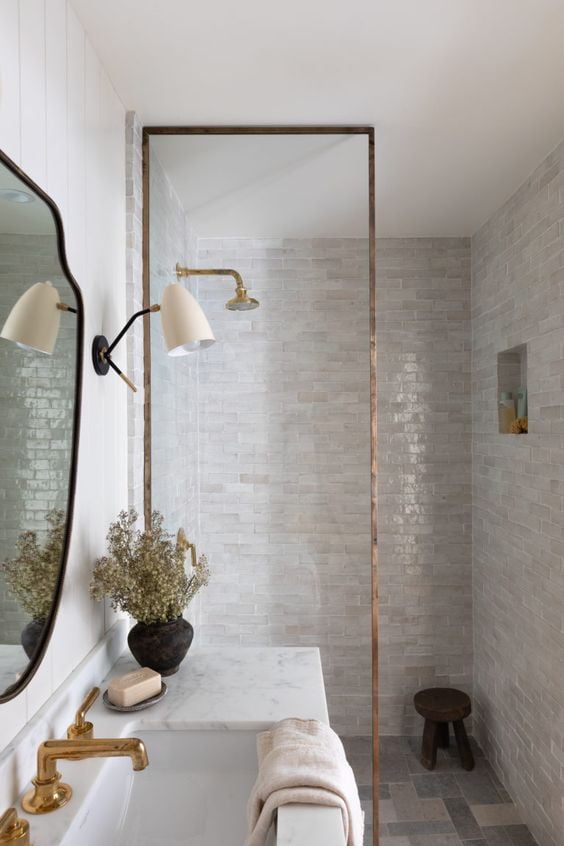
9. Arches and Curves
This one is near and dear to my heart, as we added arched doorways and arched walls all throughout the Hacienda Hideaway.

Arches are a timeless way to bring softness, elegance and movement to a room. This departure from sharp angles creates a more inviting and comfortable atmosphere.

It’s difficult to label as a trend, as it has been used in design since the beginning of time. However, it has certainly become more popular in recent years. We’re seeing it everywhere from arched shower openings, doors and tub alcoves, to vanities and sinks.
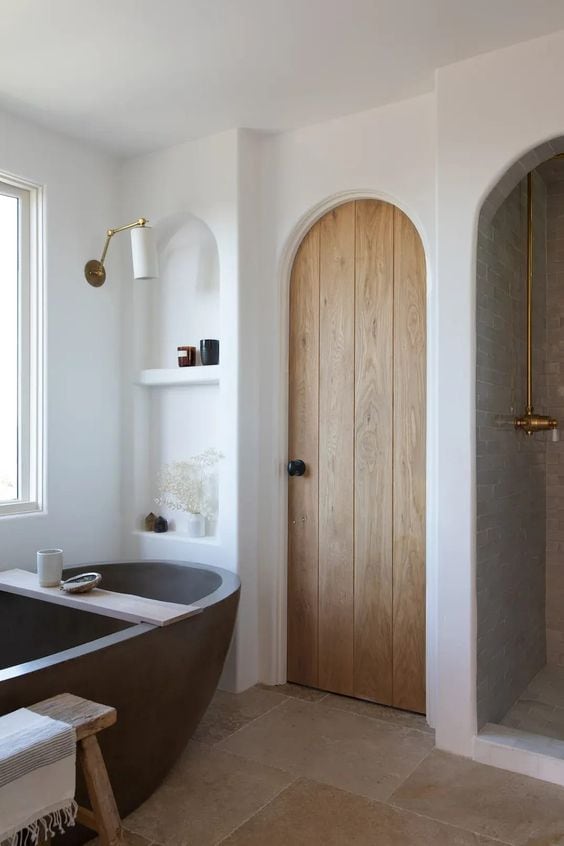
But you don’t have to tear out your door frame to incorporate curves into your bathroom—it could be as simple as rounding the corner of a countertop, or even hanging an arched mirror.

10. Accent molding
In recent years, certain styles of molding have become hugely popular—fluted, reeded, tambour and scalloped profiles have made their way onto every surface.
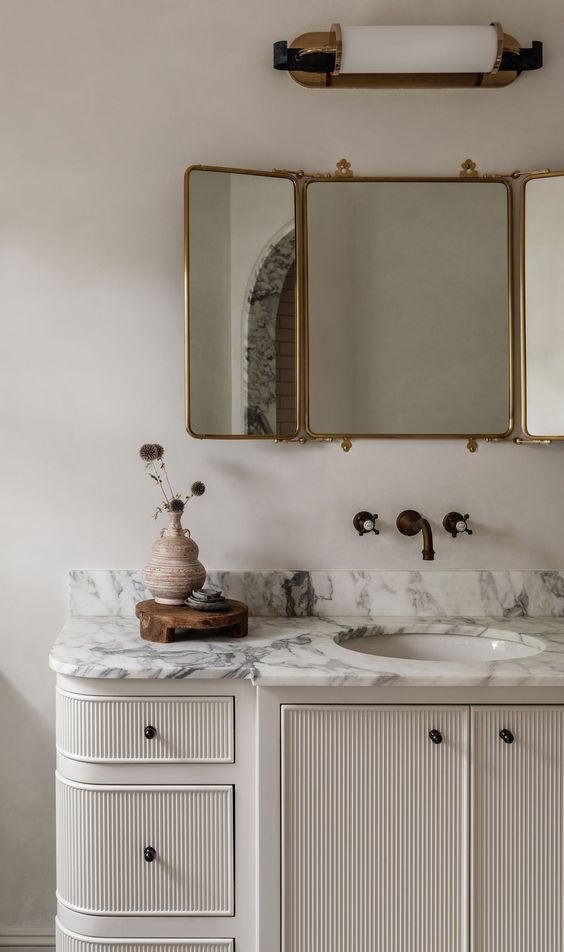
They’re a great way to add texture and interest to a plain wall or piece of furniture. Designers can create truly custom, one-of-a-kind pieces by incorporating these details in unexpected ways.

While vanities and walls are the most common application, we’re also seeing a lot of fluted and reeded stone accents.

These small details go a long way to make a room feel elevated and thoughtful. Think of them as the icing on the cake—the finishing touch that makes the room memorable.

I hope you found this roundup interesting, informative or inspiring! I’ve certainly gathered a ton of ideas for our upcoming bathroom renovations, and will be incorporating several of these trends into the designs.
Do you have a favorite trend? Do you enjoy following them, or do you prefer to stay true to your own style? Let me know in the comments, and stay tuned for more laundry room updates soon!







Jennifer Jones says
Totally agree that timeless design is the way to go! Especially love using one statement marble in a bathroom – so chic.
KJ says
Very timely. I loved that fancy scalloped sink. I am building a new home and have already picked out the tiles and countertops. Now it is time for sconces. I will say as I age I want brighter, not darker. I absolutely love those reds but they would not be friendly for my sight.
Anne S. Mercer says
Jenna, I am wondering about the upkeep of the ribbed faux-wood tile. I think it is a fabulous look but hesitate for my remodel. My concern is dirt & soap grime building up in the crevices in the shower. It’s got to be hard to clean. Since you have used it, I thought you could give your feedback on this type of product for future projects.
Jenna Sue says
The shower has only been in use since December so I can’t speak on the longevity, but the reviews I saw were great and it hasn’t been an issue so far!
Peggy says
I’m a little surprised at the idea of travertine coming back for flooring. I’ve never had it, but I’ve read plenty about how hard it is to keep clean. I’d be interested to know your thoughts on that.
Jenna Sue says
We’re planning to use travertine pavers outdoors where it will be much harder to keep clean, but it can be pressure washed. They definitely need to be sealed regardless. But, I think the aged/worn look and imperfections with travertine and other natural stone is part of the appeal.